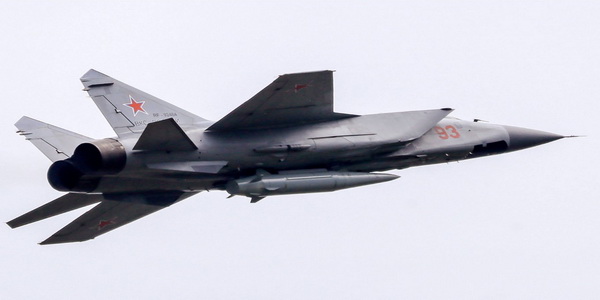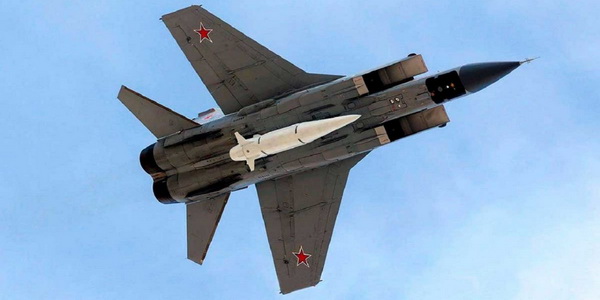Kinzhal is the name of a new Russian supersonic missile that belongs to the family of airborne missiles added to the family of Russian strategic weapons. It is symbolized by the code KH-47M2 Kinzhal and bears the NATO definition title Dagger
It recently appeared in the face of the events of the Ukrainian war as a powerful hypersonic weapon that has no equal. It was called a description "perfect weapon".
Historical overview.
Russian President Vladimir Putin first referred to the creation of this weapon during his speech to the State Duma (deputies) and the Federation (senators) of Russia on March 1, 2018, when he declared that Russia possesses a "high-precision airborne hypersonic missile system" that "has no equal in the world".

Russia successfully completed the tests of the hypersonic missile system which was on experimental combat alert at the airfields of the Southern Military District as of December 1, 2017. The President showed a video of the take-off of a MiG-31 fighter jet armed with the Kinzhal hypersonic missile on an external central hard point and computer graphics revealing the destruction of targets. terrestrial and marine.
President Putin's statement at the time came as a surprise to Russian and foreign military experts, because before that, no official or unofficial sources indicated the presence of a hypersonic weapon in Russia.
The Russian Ministry of Defense reported on March 10, 2018 that Russia carried out practical combat exercises of the high-precision hypersonic Kinzhal missile "in the designated area".
On May 9, 2018, two Russian MiG-31K fighters carrying Kinzhal supersonic missiles took part in the airshow over Red Square in Moscow during the Victory Day celebrations.
On July 2, 2018, TASS reported, citing a source in the Russian Defense Ministry, that the Kinzhal hypersonic missile will be tested on a Tu-22M3 long-range bomber, which will be able to carry several such missiles and its range will increase to 3,000 km.
On July 19, 2018, the Russian Ministry of Defense revealed the details of the trial operation of the Kinzhal hypersonic missile system. According to Deputy Commander-in-Chief of the Russian Air Force Sergey Dronov, the MiG-31K fighters carrying the Kinzhal hypersonic missile system have made more than 350 flights since the launch. Kinzhal assumed a combat posture, including 70 flights in which fighters refueled in the air. The ministry said that the air plane fighters Kinzhal hypersonic missile system has been routinely patrolling over the Caspian Sea since April 2018.
On November 30, 2019, a source in the Russian defense industry told TASS news agency that the MiG-31K fighter took off from Olenegorsk airport in the Murmansk region in the Arctic in mid-November, tested the Kinzhal hypersonic missile for the first time in the direction of the Pemboy test range located northeast of Vorkuta, and another source confirmed the test. launch, saying that "the missile accelerated to Mach 10." The Russian Air Force has not officially commented on the information provided by the sources.
On December 21, 2021, Russian Defense Minister Sergei Shoigu said at the expanded Ministry's board meeting that Russia has created a separate air regiment of MiG-31K fighters armed with hypersonic Kinzhal missiles.

On February 19, 2022, the Russian Air Force successfully test-fired supersonic Kinzhal missiles during the exercises of the Russian Strategic Deterrence Forces. On April 19, 2022, Defense Minister Shoigu reported that the target acquisition time for Kalibr and Kinzhal missiles was cut dozens of times due to the new signaling systems.
Description and design.
Despite the scarcity of technical and tactical information about it, it is often described as an advanced hypersonic air-launched ballistic missile that shares design features with the Russian 9K720 Iskander short-range ballistic missile, which Russia began working on in the late 1990s. Eighties, it is possible that the conventional version of the nuclear-capable Kinzhal, with a powerful warhead carrying more than 1000 pounds of explosives.
It is specially adapted for air launch and is launched by MiG-31 Foxhound heavy interceptors modified to carry one such missile.
The missile is considered a major qualitative leap in the Russian missile systems in terms of its design and features, as its range reaches about 2,000 km, its speed is Mach 10, and it can carry conventional or nuclear warheads and to reach an approach to the speed of the missile, the commercial Concorde planes that fly at twice the speed of sound reach their maximum speed To 2.180 km per hour, or Mach 2.04, a number by which the speed of this type of Russian missile can be measured, which is at least big three times the speed of the Concorde. This terrible acceleration provides it with a unique feature that allows it to penetrate specialized networks to catch missiles with ease.
The Kinzhal missile follows a zigzag path at a low flight altitude, while during each stage of its flight until approaching its target. Its high speed makes it more capable of penetrating and hitting heavily fortified targets, allowing it to reliably overcome the detection radars of current air defense systems and hit its targets in Depth of enemy concentrations with extreme accuracy, before detection and identification.
The missile is characterized by its ability to reach a speed of 10 times the speed of sound, and has a maximum range of destruction at a distance of two kilometers from the target when launched from the “Mig-31” launcher and three kilometers from the “Tu-22M3” bomber, and it is also planned to adapt the Tu-160 and Sukhoi-57 aircraft to carry This missile.
The first appearance of the Kinzhal missile in the circle of events was on August 18, 2022, when the Russian Ministry of Defense announced at the time that it had deployed MiG-31 aircraft equipped with “Kinzhal” hypersonic missiles at the Chkalovsk base in the Kaliningrad region, located between Lithuania and Poland, which are members of the EU. NATO".
And the first combat use of the new weapon at the beginning of the special military operation when a missile attack was carried out on an underground ammunition depot of the Ukrainian armed forces in the village of Dlyatin near Ivano-Franciysk.
Strategic Implications:
The missile is designed as a deterrent measure against US and NATO warships that pose a threat to Russia's missile systems and is designed to fly at supersonic speeds within seconds of launch and perform maneuvers at any time during flight, allowing it to defeat any air defense systems or Known missiles in the United States including the MIM-104 Patriot system, and the Terminal Altitude Area Defense system (THAAD) are also known.

The missile can be launched from unpredictable locations, which may strain cross-sectional radars such as those used in the Patriot system. Since there are no means of defense against it at present, it mainly threatens and endangers the region, thus providing significant strategic leverage for Russia.
Moscow may not want to use these missiles indiscriminately, but due to the ability of the large Kinzhal missiles to reach important and vital targets, several European capitals have made them within the range of these missiles through their stationing sites that have been determined in the Russian Kaliningrad region bordering Poland, Lithuania and the Baltic Sea, which makes a capital like Berlin, Which is 600 km away from Kaliningrad in the achieved range of these missiles, and this increases Moscow's ability to continue fighting and gives it the advantage of powerful missile strikes whenever it wants against its opponents.
Kinzhal projection.
The Ukrainian leadership claimed that it shot down a Kinzhal missile during the ongoing war operations last week. Many experts questioned the Ukrainian version, which was described as a myth and was not based on significant evidence except for some pictures of missile wreckage with letters in the Russian language. At that time, a spokesman for the Russian Ministry of Defense refuted the Ukrainian allegations, saying "The fact is that the flight speed of the Kinzhal missile exceeds the maximum known combat modes of anti-aircraft missile systems supplied by the West to the Kiev system, including the Patriot."
Therefore, the claim seems false, especially if we know that the "Kinzhal" missile, in the last stage of its flight, performs an anti-missile maneuver and adopts a vertical position when it falls on the target, which excludes the possibility of interception by the anti-aircraft missile systems currently operating in the combat zones.
When we know how the American PAC-2/PAC-3 SME interceptors work, their speed, and the speed of the Kinzhal missile, it is very difficult to explain how a slower-moving body can hit a faster-moving body at an angle. We are not saying that it is impossible, but that it is very difficult.
Russian Defense Minister Sergei Shoigu said that the missile was used three times during the special operation and in all cases showed its remarkable characteristics. At the same time, the head of the military department did not specify exactly what targets the "Kinzhal" hit.
The specifications of the Kinzhal missile:
- Design and production: Russian company TASS for the Russian Ministry of Defense.
- The length of the missile: 8 meters - the width is 1 meter
- Speed: Mach 10 (12,250-14,700 km/h).
- Range: 2000 km from the MiG-31 fighter - 3000 km from the TU22M3 fighter
- Type and weight of the warhead: nuclear - conventional - with a weight of 500 kg
- Guidance system and accuracy: inertial and GLONASS satellite navigation with a terminal seeker.
- Circular error rate: 8 metres.
- Fuel type: single-stage solid fuel.
- CeilingFlight : 20 km.
- Operating platforms: Russian fighters (Mig31 - TU22m3 - Su27).
